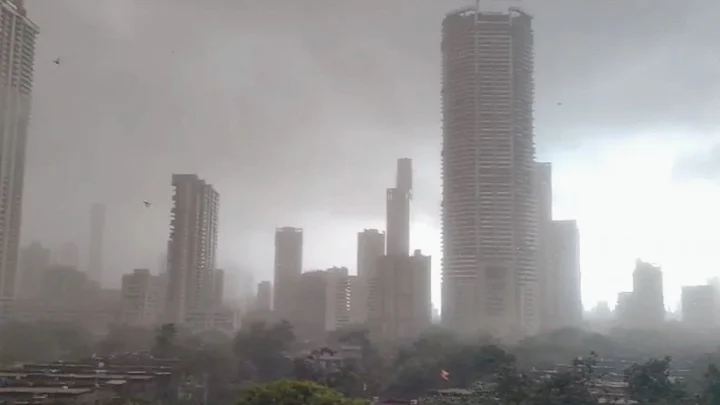A dust storm hit Mumbai in the second week of May and caused widespread damage to buildings, roads, and power lines, leading to the cancellation of flights and trains. The storm was caused by a combination of factors, including high winds, low humidity, and dry conditions. The government of Maharashtra, the state where Mumbai is located, declared a state of emergency in response to the storm. The storm lasted for a couple of days and caused significant disruptions to daily life in the city.
The exact number of people affected by the dust storm is not readily available. However, we can infer that the impact was significant considering the widespread damage to buildings, roads, and power lines and the cancellation of flights and trains. This suggests that many individuals, including residents, commuters, and travellers, were affected by the disruptions caused by the storm.
The Dynamics Behind Mumbai's Dust Storms
Dust storms in Mumbai emerge from a complex interplay of natural phenomena and human activities. A synthesis of these factors sheds light on the dynamics shaping the city's atmospheric landscape.
Primarily, Mumbai's arid and sweltering climate during the summer months provides fertile ground for dust storms to take root. Intensified by soaring temperatures, the parched air sets the stage for a whirlwind of dust and debris. The transformation of urban sprawl has played a significant role. Deforestation and rapid urbanisation have stripped Mumbai of its green cloak, leaving soils vulnerable to erosion. Consequently, even moderate gusts can lift dust particles into a frenzied dance.
Industrial and construction activities lend a heavy hand in stirring the dust pot. Factories and building sites churn out particulate matter, which mingles with natural elements, exacerbating the issue during windy spells. Agricultural practices in the surrounding areas, notably tilling and dry farming, further contribute to the aerial ballet of dust. Such activities disturb soil equilibrium, liberating particles that join the atmospheric troupe.
Geographical intricacies weave into this narrative. Mumbai's proximity to the Arabian Sea and neighbouring arid regions amplifies its vulnerability—winds laden with sand and dust, the journey from distant lands to rendezvous with Mumbai's skyline. Topographical nuances add another layer.
Low-lying pockets and dust accumulation zones amplify the storm's intensity, perpetuating its tumultuous course.
Understanding these multifaceted factors unveils pathways for intervention. Sustainable urban planning, reforestation initiatives, and stringent regulations on industrial emissions offer avenues to temper Mumbai's dusty dalliances.
The Link Between Dust Storms and Climate Change
The pertinent question is – is there any link between climate change and dust storms?
The evidence suggests that climate change can influence the frequency and intensity of dust storms. Global climate shifts cast a long shadow, contributing to dust storms. Changes in larger weather patterns ripple down, potentially altering Mumbai's atmospheric rhythm and further fuelling the dust storm saga.
Changes in temperature and precipitation patterns can affect soil moisture levels and vegetation cover, influencing the susceptibility of soils to erosion. Warmer temperatures can exacerbate certain regions' drought conditions, making drier soils more prone to wind erosion during high winds.
Additionally, climate change can alter atmospheric circulation patterns, which may contribute to the generation and movement of dust storms over large areas. For example, shifts in the location and intensity of weather systems, such as high-pressure systems and monsoons, can influence wind patterns and dust transport pathways.
Climate change can exacerbate land degradation processes, such as deforestation, overgrazing, and unsustainable land management practices, increasing the availability of loose soil particles for wind erosion.
Overall, while individual dust storms cannot be directly attributed to climate change, the underlying environmental changes driven by climate change can contribute to the conditions that favour the occurrence and severity of dust storms.
Safeguarding Mumbai Against Dust Hazards
As dust storms sweep through Mumbai, it's imperative to prioritise safety and minimise the impact of these natural phenomena. These storms not only pose immediate hazards but can also have long-term health implications. To safeguard the people and community during such events, adhering to some fundamental precautions is crucial.
First and foremost, individuals should seek refuge indoors in the evening of the warning. Shutting windows and doors is a barrier against infiltrating dust, safeguarding indoor air quality. Investing in air purifiers can further enhance this defence, ensuring a cleaner breathing environment.
It is advisable to avoid unnecessary travel during these storms, as compromised visibility increases accident risks. If venturing outside becomes unavoidable, individuals should don masks to shield their respiratory systems from harmful dust particles and protect their eyes with goggles or sunglasses to prevent irritation.
Staying informed remains paramount. Keeping abreast of weather forecasts and heeding alerts from local authorities is essential. Individuals should secure loose objects outdoors to prevent them from becoming projectiles in the storm's ferocious winds.
Additionally, it is advisable to stock up on emergency supplies and check on vulnerable individuals in the community. Post-storm, caution before venturing outdoors is crucial, as residual dust may still linger. By adhering to these recommendations, individuals can fortify themselves against the perils of dust storms, ensuring safety and well-being for all in Mumbai.
[Anjal Prakash is a Clinical Associate Professor (Research) at Bharti Institute of Public Policy, Indian School of Business (ISB). He teaches sustainability at ISB and contributes to IPCC reports. This is an opinion piece and the views expressed are the author’s own. The Quint neither endorses nor is responsible for them.]
